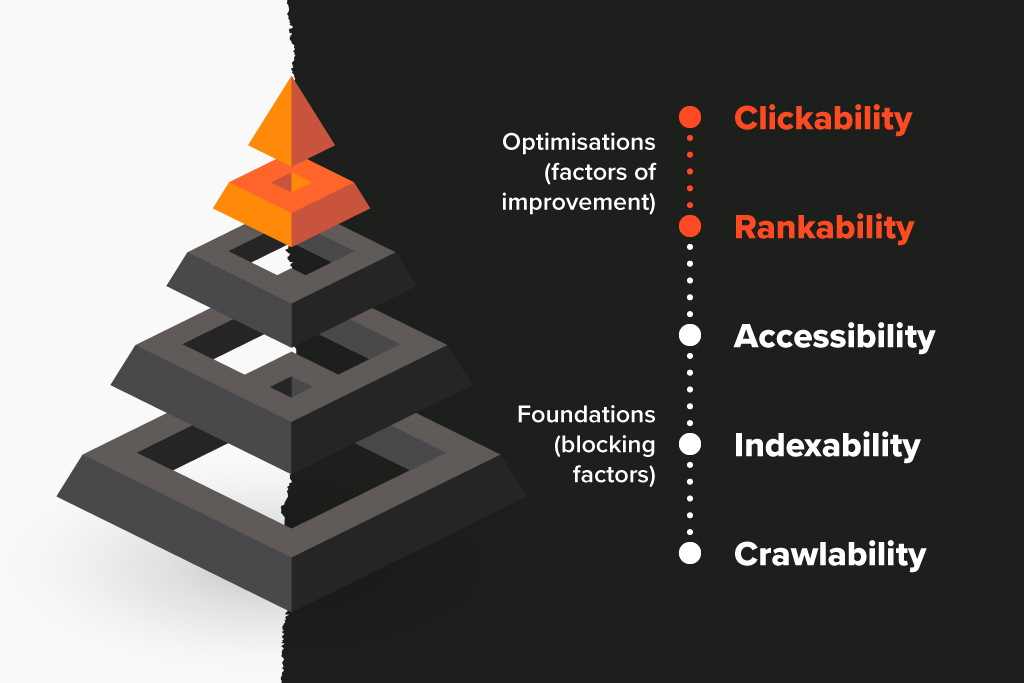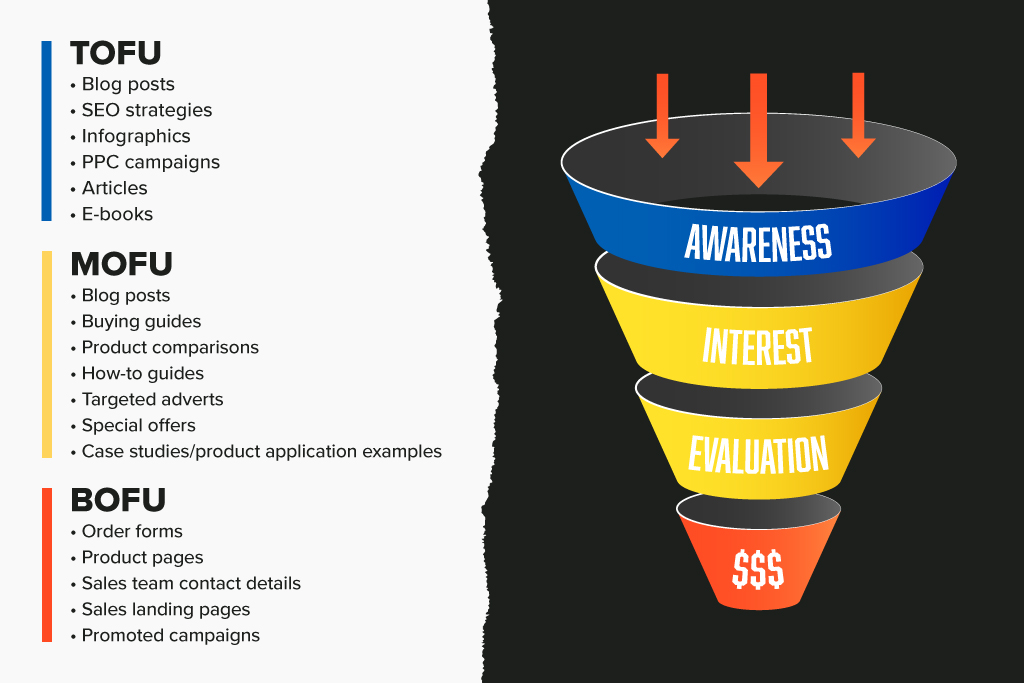
So what are the three pillars of SEO? Putting it simply, these are the three main areas that any SEO agency will need to focus on when looking to create a strategy to increase organic visibility and revenue for online businesses.
We’ll go into more detail on each later, but as an overview, these are:
Technical SEO
Technical SEO is the process of making sure that a website can be crawled, indexed, and understood enough to rank on Google for its various pages and targeted keywords.
Pages need to be crawlable and indexable before they can be ranked, and it doesn’t matter if you have the best content in the world; if Google cannot crawl or index your page, you’re not getting ranked.
Technical SEO is like the foundation of any good SEO strategy. Without it, it will likely crumble.
Content
We need the right pages with the right optimised content in order to rank pages. It’s all good to ensure your website is crawlable and indexable, but without content, you cannot expect to rank for a search query.
For example, if you sold Pikachu pyjamas, you would not stand a chance of ranking and driving traffic from Google’s organic listings if you did not have a page that is called “Pikachu pyjamas”, which has products that are Pikachu pyjamas, and talks about how great Pikachu pyjamas are.
Off-page SEO
Off-page is all of the expertise and quality signals needed from external sources to show Google your business is and can be trusted online. Without this, it is much much harder to rank.
Examples of this could be reviews, backlinks (including digital PR), PR coverage, and Google Business Profile (For local SEO).
Pillar 1: Technical SEO

Technical SEO can be split into two main areas:
SEO foundations
Often referred to as blocking factors, these are not ranking factors but more factors that prevent or slow down the ability of search engines to crawl, index, or access your website. Examples for each are:
Blocking factors
- Robots.txt – Using the robots.txt file to block access by crawlers to certain pages or page paths to prevent crawling on pages that should be indexable.
- Noindex tag – Another accessibility issue would be to include ‘noindex’ tags on pages that should be indexable.
- Sitemaps – Ensuring all pages you want indexing are available via an XML sitemap is important for crawlability.
- Navigation – A well-structured internal navigation is important to make it easy for search engines to crawl important pages of your website. Orphaned pages are going to be missed or deemed not important.
- Javascript – Rendering/loading content onto the page via Javascript can cause crawlability issues due to how Google bot crawls and handles Javascript files.
- Canonicalisation – Incorrect use of canonical tags can cause Google to ignore URLs completely from its index.
Factors of improvement
Otherwise known as optimisations, these are ranking factors and clickability factors. These are mainly on-page factors, but some off-page factors come into play. Examples of each are:
Rankability factors
- Page load speed – How fast a page fully loads on a mobile device is a direct ranking factor. It’s important for users on mobile devices to be able to interact with the page quickly.
- Core Web Vitals – A series of metrics aimed to evaluate page experience. This is also somewhat linked to page load speed, as a poor page load speed can be a negative page experience. Again, this is a ranking factor.
- Mobile Usability – How well the page is viewed and interacted with on a mobile device is a direct ranking factor.
- Optimising metadata – Page headings and title tags are key and important on-page SEO signals.
- Internal Linking – Internal links not only help Google find and crawl pages but pass PageRank throughout your website, which is a part of Google’s many ranking systems.
- Improving content quality – Poor quality content will not help with ranking or topical authority. Helpful content that’s written for actual humans/customers will go a long way to improving your rankability.
Clickability factors
- Optimising Title Tags – Title tags should go beyond being optimised for search terms but also should be used to help with click-through rates from search engine results pages.
- Optimising Meta Descriptions – Despite meta descriptions not being a direct ranking factor, compelling and well-written meta descriptions can help with click-through rates from search engine results pages.
Pillar 2: Content
Content is a vital part of any SEO strategy, and quite simply, without content, you cannot expect to rank or generate leads/sales. Content can generally be separated into three main categories, these are:
Top of the funnel content
Otherwise known as the awareness stage, this is content that’s written for customers who may not yet be aware of your brand/services or might aware of a problem or need but are not yet aware of the solution. Examples of this type of content are:
- Blog posts
- Infographics
- Articles
- E-books/Podcasts
Middle of the funnel content
Otherwise known as the interest and evaluation stage, this is content that’s written for customers who are aware of the solution to their problem or need but are not brand aware. Examples of this type of content are:
- Blog posts
- Buying guides
- Product comparisons
- Category pages
- How-to guides
- Case studies
Bottom of the funnel content
At this stage, customers are the most aware of the solution and your brand, products or services. This can be known as ‘money content’. Customers are more likely to come to you directly. Examples of this type of content are:
- Order forms
- Product pages
- Sales team contact details
- Sales landing pages
- Promoted campaigns
Pillar 3: Off-page SEO

Not everything done on your site builds authority; there are things you can do to build authority off-site too. This is known as off-page SEO.
There are many examples of off-page SEO; we’ll cover the fundamentals here.
1. Link building
Probably the most important off-page SEO factor whilst being one of the most difficult to get right. Link building is the practice of getting relevant websites to your products and /or services to link to pages on your website.
In theory, the more backlinks a website or page has from high authority websites, as well as smaller relevant websites, the more trustworthy it may seem to Google, which in turn can help the page rank higher. It’s critical, though, that you have good technical SEO foundations and the right content on your site in the first place.
Once deemed as the most important ranking factor by many SEOs, Google’s systems have evolved enough now that backlinks, despite them still being important, are no longer considered a top 3 ranking signal.
2. PR
The role of PR in SEO has developed over the years. In the past, PR campaigns could provide an important brand building for your online brand, but through the use of Digital PR, we can use the same PR tactics to build high authority backlinks to pages/websites.
The importance of brand building for SEO is also growing; with Google putting more emphasis on ‘perspectives’ in Google search, Digital PR services and brand building will continue to be an important off-page SEO tactic.
3. Customer reviews
Customers want to see trusted reviews on your company, products, or services. Google is no different. Having trusted reviews on platforms like Trustpilot and Google reviews is a strong signal that your online business can be trusted enough to be rankable in the search engine results pages.
4. Content marketing
Content marketing can be an important SEO technique. The content we create for SEO can often be re-distributed across social media, email marketing, and guest posting, and can even be turned into podcasts!
Content distribution is becoming more and more important and should be a tactic for any content marketing agency, as it helps build a brand where Google is seemingly now rewarding more than ever.
5. Influencer marketing
Another content marketing tactic that deserves its own spotlight is influencer marketing. Working with influencers on social media platforms like TikTok as well as YouTube, they can generate search interest for online business products and services.
This has become a more prominent tactic among big brands, especially in the fashion industry, as they use content creators to increase search demand for products that may not have had much awareness otherwise.
6. Local SEO
Creating and optimising Google business profiles (formally Google My Business) is an important part of any local SEO strategy and is an off-page process.
Other local SEO tactics are NAP citations, often known as business directories. This is the process of getting key information about a local business (name, address, phone number, website address). Not only is this needed across business directories but social media and review sites also.
Search engines like Google use NAP citations to confirm your business is legitimate and that the information on your business is accurate.
Final thoughts
For a successful SEO strategy, you must ensure you have the right balance of all three pillars. There’s no point in focusing on link building if there are critical blocking factors preventing the pages the links point to from being indexed.
Likewise, you can have a solid technical foundation, but without the right content and off-page SEO strategy, you’re not going to compete in the SERPs.
Always make sure that you carefully audit a website before putting an SEO strategy together to ensure that the right balance is in place. Not all websites will be the same, and this is the same as your strategy. An audit might reveal that more emphasis might be needed on content than technical SEO and off-page SEO, for example.



